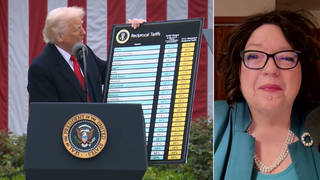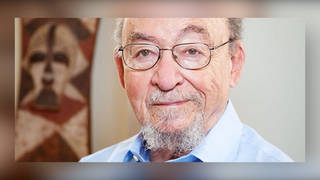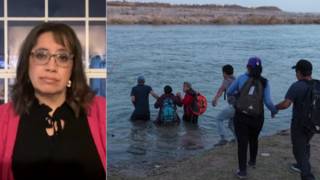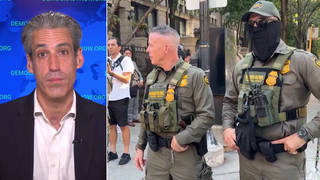
Guests
- Laura Gottesdieneraward-winning Democracy Now! producer and correspondent.
- Renée FeltzDemocracy Now! correspondent and producer who has long reported on the criminalization of immigrants, family detention and the business of detention.
As the Trump administration accuses migrants of illegally entering the United States, Democracy Now! went to the international bridge in Brownsville, Texas, and found asylum seekers waiting for days in the hot sun after being told the United States was full. We are guided by Christina Patiño Houle, director of the Rio Grande Valley Equal Voice Network, and Michael Seifert of the ACLU. We also speak with Juanita Valdez-Cox, longtime farmworker organizer and executive director of La Unión del Pueblo Entero (LUPE), about the separation of families at the border, and attempt to interview an official at Case Padre, the Southwest Key detention center housed in a former Walmart.
Transcript
AMY GOODMAN: The Department of Health and Human Services is refusing to disclose how many migrant children separated from their parents at the border they’re still holding. Last week, the HHS Secretary Alex Azar said 2,047 separated minors were still in the care of the Office of Refugee Resettlement. But the department has refused to give updated numbers, even though the Trump administration is facing a July 10th court-imposed deadline—that’s next Tuesday—to reunite all separated children under the age of 5 with their parents. Two weeks later, all children must be reunited.
Meanwhile, the separated children continue to be sent around the country from the border. We saw this firsthand at the airport in Brownsville when we were reporting on the U.S.-Mexico border in South Texas. We’re just back. And today we take you along that journey that we went on, from meeting with asylum seekers at a legal port of entry to talking with an airport worker who describes children being brought in early in the morning in order to be flown out to other states.
I’m here in the studio with Democracy Now! producers Laura Gottesdiener and Renée Feltz, who I traveled with to the Mexican border. We encountered these children ourselves at the airport. The Trump administration has been saying that people are illegally entering the United States, so we went to the international bridges in Brownsville, the legal port of entry and the legal way to enter, found asylum seekers sitting for days on the bridge in the hot, baking sun, them and their children, after being told the United States—the country—was full. We go on the bridge with Christina Patiño Houle, who is director of the Rio Grande Valley Equal Voice Network, and Michael Seifert of the ACLU.
AMY GOODMAN: This is Democracy Now! I’m Amy Goodman, with Renée Feltz. And we’re walking over what’s called the Old Bridge, from Brownsville into Matamoros.
RENÉE FELTZ: We’re about to pay a dollar in quarters to cross into Mexico, and we hope to meet with people who have been waiting here for days, potentially weeks, seeking asylum in the United States, but have been turned away.
AMY GOODMAN: And we’ll see what happens, if there are any migrants on the bridge. We’ll go over to the Mexico side, and then we’ll come back.
CHRISTINA PATIÑO HOULE: My name’s Christina Patiño Houle, and we’re at the Old Bridge at the border of Brownsville and Matamoros. And we’re about to cross into Matamoros. So this bridge spans the river, that is what makes the border here. And the actual border is in a midpoint on the bridge.
AMY GOODMAN: So, we’re crossing over the international border between the United States and Mexico. Below us, the Rio Grande. Christina, there’s a tent, a kind of makeshift tent, on the car bridge, which is right next to us. We’re on the sort of pedestrian walkway, right below it. And they are now stopping migrants coming over from Mexico right there at the line, at the border?
CHRISTINA PATIÑO HOULE: Yes, exactly. So, it’s new that they have a tent for the agents on the pedestrian side, on the—as you cross from Mexico into the United States. And that tent is only for the agents. It’s not for the people seeking asylum. So, there’s a line now of people seeking asylum, without shade or shelter. And what’s new now, that we’ve seen in the last few weeks, is that—previously, you could cross the actual boundary, the actual border, into the United States, and you would get off the bridge, and after you’ve crossed into the United States, you can make a case for your asylum. Legally, you—the United States government is obligated to see you and to process your case for asylum. But now that they’re stopping people at the boundary, you don’t have permission to make that request until you step foot into the United States.
AMY GOODMAN: So, we’ll be going through Mexican customs right now.
CHRISTINA PATIÑO HOULE: As you can see, when we crossed into Mexico from the United States, there was no agent asking for our documents on this side. It’s all a new development and very makeshift on the part of the United States.
AMY GOODMAN: We’ve just come into Mexico. We crossed over the highway. And we’re now going to cross back into the United States. So, Michael, what about all this? So this is the cars coming from Mexico.
MICHAEL SEIFERT: Yeah.
AMY GOODMAN: Into the United States.
MICHAEL SEIFERT: And up here will be a line of people who are going to want to ask for political asylum, but who are being stopped at the top of the bridge, in the sun, and told they have to wait their turn, that there’s no capacity to process them, when, in matter of fact—I think I see a baby crib already up there.
AMY GOODMAN: So, we’re coming away from the migrants who are sitting on the bridge, trying to pass into the United States, Democracy Now!’s Laura Gottesdiener with us. Laura, talk about the woman who was on the bridge.
LAURA GOTTESDIENER: Sure. So, Evelyn explained that she and her 2-year-old daughter Jennifer fled Guatemala because of a domestic violence situation, the father of her daughter. And, you know, when I asked, she said, “I went multiple times to the police. And every single time, they said, 'I can't help you. I’m not going to help you.’” So, when I finally asked, “Do you think there’s any protection for you, as a woman, in Guatemala in a domestic violence case, she said, “No, my only option is to come to the United States.” And she’s got family here, and she’s hoping that she’ll be able to apply for asylum.
The problem is that, you know, she’s been camped out on the bridges now for four days. They haven’t even allowed her—in violation of domestic and international law—to apply for asylum. But if she does get in, it will be probably a challenging situation, because Attorney General Jeff Sessions did recently announce that domestic violence cases will no longer serve as a basis for political asylum, which is a very big problem for thousands upon thousands of women fleeing Central America and other places.
AMY GOODMAN: So, that is the old international bridge in Brownsville, Texas, between Brownsville and Matamoros, Mexico. We also went to the new bridge and found exactly the same thing. Democracy Now!’s Laura Gottesdiener and Renée Feltz are in the studio with us right now. Laura, as you talked to this 21-year-old Guatemalan mother with her 2-year-old child, too afraid to be shown on camera, but desperate, she had been on both bridges?
LAURA GOTTESDIENER: Yeah, exactly, Amy. So, she had waited on one bridge and been told the U.S. is not allowing anybody in. So then she, finally, after about a day and a half, went to the next bridge, and they told her, you know, “The U.S. is full. You have to wait.” She had some hopes, because the Border Patrol was letting in about a family a day. This is one of the major international points of entry and legal ports of entry.
And, you know, what was encouraging was we saw a bunch of food, a bunch of clothes, a bunch of Gatorade. The people on the bridge, Evelyn and the other immigrants, were saying that both people from the U.S. and Mexico, just regular civilians, had been coming to the bridges to make sure that they had food, had water. But we have to remember, it was over 100 degrees. Evelyn mentioned that her 2-year-old daughter Jennifer was, you know, suffering allergies. This Mexican health worker came by, said he probably thought it was heat rash. And when asked—you know, even though the U.S. has said, or Trump Administration has said, it will no longer separate families, when asked, was she concerned about family separation, she said, “Yeah, I am concerned about it, but this is my option.”
I think it’s important to remember, you know, there’s a long history of the United States denying Guatemalan asylum cases. During the 1980s, at the height of the armed conflict, when the U.S. was training and funding what is now well understood to be a genocide, the United States denied 98 percent of all Guatemalan asylum cases. So this is not new. This has been happening for decades. It happened, obviously, under the Obama administration, as well.
But what we have to remember is that domestic and international law came about after World War II. And particularly one of the most famous cases was the steamship MS St. Louis, which docked right off Miami Beach. It was so close, the 900 Jews aboard who were fleeing Nazi Germany could see the lights of Miami. And the United States was so concerned that not a single one of them reach U.S. shores in order to try to stay and seek safety, that they sent the U.S. Coast Guard to patrol the ship and the waters all around the ship to make sure nobody set foot in the United States.
AMY GOODMAN: And that’s really important, because there is a change, as you heard, on this bridge. The U.S. border guard have now moved directly a makeshift setup right on the border, rather than on the U.S. side of the bridge, so that immigrants, Renée, cannot walk over. Once they do, they have to be taken into custody, if they’re applying for political asylum.
RENÉE FELTZ: That’s right. And we saw guards posted right there at the halfway point. The guards had a tent, shielding them from the sun; the asylum seekers didn’t. And they had been there for weeks, they said, just following orders, turning people away, making them wait. It’s something that people that live there have never seen before.
AMY GOODMAN: I want to go to a conversation that we had in Brownsville. It was on Thursday, right before a massive rally, one of the biggest that Brownsville had seen, outside the federal courthouse, where migrants were being brought, day after day, in groups, to face judges. And it’s—you know, Brownsville is where so many of the children have been separated. The big rally was the “Keep Families Together” rally. And we spoke with Juanita Valdez-Cox, longtime farmworker organizer, executive director of LUPE, which stands for La Unión del Pueblo Entero, the Community Union. She described the separation of children from their parents being deported alone.
JUANITA VALDEZ-COX: This family, the father was traveling with his 8-year-old and his 10-year old son. And when they crossed the border, they were apprehended by immigration. And so the father is here at a detention center, actually not too far from here, called La Villa detention center. And the children were placed separately. So, the father calls the family and—and, of course, frantic and worried that the children—that he didn’t know where the children went. And so, we were trying to get the children together and get—and we didn’t want to call the father, because we couldn’t find them. For three days, it took—it took us meeting with the Human Rights Commission from Mexico, a group of six people coming to our office, and us telling them the story of the children, and “Could they go back into Mexico and see if they could find them?” It was also the father of one of our staff members that works with us, that helped us in Mexico trying to find the children. We finally found them. An 8- and 10-year-old were deported on their own, and the mother didn’t know where they were, and the father didn’t know where they were.
AMY GOODMAN: What does it mean, they’re deported? How are they left? Where do they go?
JUANITA VALDEZ-COX: They leave them—they leave them at the border. If it’s closed, they just put them in the paddy wagons for the Border Patrol, and then they drop them off at the border, and the children cross into Mexico. But children—
AMY GOODMAN: They drop an 8- and 10-year-old child on the border, and they’re supposed to go into Reynosa?
JUANITA VALDEZ-COX: They went into—they went into Reynosa. And hopefully—there’s a shelter in Reynosa, but it has been crowded, because there are so many that are being dropped off there. Now, if you’re from a further country, they can put you in an airplane and then fly you back. But we’re so close to the border that they could just drop you off. They don’t need to—but the thing is, they’re not responsible after they just drop them off there, right? It’s just—it’s just incomprehensible that that is—that that is what is happening.
AMY GOODMAN: First of all, it’s known how dangerous Reynosa is, even for adults.
JUANITA VALDEZ-COX: Right.
AMY GOODMAN: Speaking about child abuse, they dropped an 8- and a 10-year-old child on the border and told them to go into Mexico? And to whom?
JUANITA VALDEZ-COX: Well, we hope that the U.S. government is contacting with the Mexican government on the children, so that they have some assistance when they cross the border, so that they’re not by themselves, right? But we were not able to find them for three days. And so, it’s so dramatic.
AMY GOODMAN: The family was not able to find them for three days?
JUANITA VALDEZ-COX: No, we found them for three—LUPE, La Unión del Pueblo Entero, working with lawyers, with the Human Rights Commission, with a consulate in—of their country, and we still took us three days to find them.
AMY GOODMAN: And where were they from?
JUANITA VALDEZ-COX: They are from Tabasco, Tabasco, Mexico.
AMY GOODMAN: So, that’s Juanita Valdez-Cox, the executive director of LUPE. And then she had this to say.
AMY GOODMAN: You’re talking about a 9-month-old child and a 1-year-old child alone, separated from their parents.
JUANITA VALDEZ-COX: Yes. They are in this detention center, but the parents are not there. And when the congressmen went in to see that, when they come back out and talk to the community, we had a meeting with them. They are the—they tell us what they see. And this is what they were seeing. Now, we put together what the congressmen see and the phone calls we get of parents that are looking for their children. Many times they can get a hold of a relative, and the relative comes to LUPE or to other nonprofit organizations and says, “We need your help in finding our children.” And so we know that this is happening. We know that they’re being separated. And the other thing that is just heartbreaking is to see that when the children crying, yes, they can feed them, and, yes, they can change their diaper, but they’re not allowed to—they’re not allowed to pick them up and to hold them and to soothe them.
AMY GOODMAN: They’re not allowed to hug them?
JUANITA VALDEZ-COX: No, not at all, because, apparently, the government wants to be careful about, I think, child abuse. Isn’t that ironic? They’re already doing—they’re already doing the worst thing that could happen to the children. And so, this is the situation that we’ve been going through, maybe for the last six or eight months, since this administration started that “zero tolerance” policy.
AMY GOODMAN: Again, that’s Juanita Valdez-Cox, head of the group LUPE. We spoke to her just before a massive rally in Brownsville on Thursday. On Friday, we went to find the separated children. They’re in a number of detention centers, but we went to the largest. It’s become quite well known. It’s the old Walmart in Brownsville, called now Casa Padre.
AMY GOODMAN: I just wanted to know: Is this where the 1,500 children are being held?
GUARD: No comment. I’m sorry.
AMY GOODMAN: OK. Well, as you can see, the sign says, “Welcome to Southwest Key Programs, Casa Padre.” This is an old Walmart in Brownsville, Texas, and it’s where, it’s believed, 1,500 children are being held, are being caged. Congressmen have come here, asked to come inside, have not been allowed to. Senator Jeff Merkley came here.
Ma’am? Ma’am? Ma’am? Ma’am, we just want a statement from Southwest Key.
Sheriff, we want to speak to someone, and we’re saying—
SHERIFF’S DEPUTY: I know you do, ma’am.
AMY GOODMAN: —”Can we call a supervisor?”
SHERIFF’S DEPUTY: I know you want to speak to someone.
AMY GOODMAN: Right.
SHERIFF’S DEPUTY: But I’m not authorized to answer your questions. I know you want to speak to someone.
AMY GOODMAN: Right.
SHERIFF’S DEPUTY: But if they’re not answering, they’re not answering, and I can’t help you with that.
AMY GOODMAN: But we have a responsibility as the press. There’s—
SHERIFF’S DEPUTY: And I have a responsibility for this property.
AMY GOODMAN: Yes. But there’s 1,500 children jailed inside.
SHERIFF’S DEPUTY: OK.
AMY GOODMAN: The press needs to know what is happening.
SHERIFF’S DEPUTY: I’m sure.
AMY GOODMAN: And that so—
SHERIFF’S DEPUTY: I agree.
AMY GOODMAN: —we want to speak to someone.
SHERIFF’S DEPUTY: Ma’am, then you have to go through the proper channels and the proper protocol for that.
AMY GOODMAN: We did. But that number, no one answers.
SHERIFF’S DEPUTY: I can’t help that. That’s the number we’re given to give out.
AMY GOODMAN: But we have a responsibility here. We have to speak to someone. And there is certainly—there are hundreds of people who work here. And we want to speak to one of them. We want to speak to a person in charge who can just answer our questions. That’s all we’re asking. You’re doing your job. We’re doing ours.
SHERIFF’S DEPUTY: Right. And that’s fine. But like I said, I can’t help you.
AMY GOODMAN: But that’s why we want someone to be called from inside who can come and who can help us. I recognize you’re a sheriff who’s working on the outside. And we need someone from inside of Southwest Key who can talk to us about what’s happening inside.
SHERIFF’S DEPUTY: Like I said, ma’am, you want to film all you want outside the barricades, you want to interview whoever’s out here, that’s fine. But you can’t just pass the barricades. And I can’t answer your questions. And I apologize.
AMY GOODMAN: We’ve come to the Southwest Key Programs facility, where up to 1,500 children, migrant children, are being held in cages inside. We want to know what’s going on. We asked to speak to a supervisor. The sheriff’s deputy, security all came out in their golf carts wherever we came, to this vast facility, very few windows, and the windows we see are blacked out. There are barricades up that say “keep out.” We asked to speak to a supervisor. They said they could only give us a phone number. That phone number, no one answered. Then we were able to leave a message. When we left the message, a while later someone did call back and said we’d have to call the Office of Refugee Resettlement. They said, possibly, we could get an interview in the next 10 to 14 days. We called the number they left, and there’s no answer. Again, this is where up to 1,500 children are being held. The barricades say “keep out” and “private property.”
AMY GOODMAN: “Private property.” The children, private property, detained in cages inside. When we come back to break, we race to the airport. We meet with a child who was just released from Casa Padre. Stay with us.












Media Options